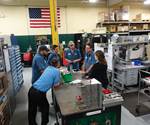How Industry 4.0 Will Impact Moldmaking and What You Can Do Today to Maximize Production
Tebis America presented the benefits of implementing exact simulation of the real manufacturing environment in the virtual world.
Industry 4.0 is coming to moldmaking, and all of manufacturing. It is time for moldmaking companies to seriously address the benefits of networked production and how to implement it in their operations using technologies and equipment that is available today, according to Michael Thiessen, sales manager for Tebis America, who presented a webinar on the topic last week.
“Networked Manufacturing gives a complete picture of what is possible today to create a virtual manufacturing world inside the CAD/CAM solution,” Thiessen told attendees. “It makes it possible to predict what the outcome will be, not realize after the fact and then react to issues that arise. Industry 4.0 is coming. Once it comes, it will be all digital. There is a clear movement over the last 20 years towards full automation.”
In the webinar, Thiessen explains why digitization of the shop floor is so important, and he discusses the three main focal points that Tebis has zeroed in on to help shops maximize the utilization of their manufacturing resources. They are: Efficiency, Automation and Organization. “Every manufacturing company wants to get as close to maximized production, running 24/7/365, as possible,” he says. “But it is more than just the software that is key to meeting that objective. It is also utilization of state-of-the-art tooling, five-axis technologies, in-process measurement and having the ability to control the machining processes. In other words, knowing exactly where you are at any point in time and knowing exactly the next step in your production cycle.”
To learn more, and to listen in on the question-and-answer session that followed Thiessen’s informative presentation, click here to listen to the FREE archived webinar. While there check out our other webinars, both archived and upcoming.
Related Content
-
Tolerancing in Mold Design, Part 2: Using GD&T to Address Conventional Tolerancing Issues
Mold designers can achieve a single interpretation of workpiece functionality when following the American Society of Mechanical Engineers Geometric Dimensioning and Tolerancing standard.
-
Mold Design Review: The Complete Checklist
Gerardo (Jerry) Miranda III, former global tooling manager for Oakley sunglasses, reshares his complete mold design checklist, an essential part of the product time and cost-to-market process.
-
What Is Scientific Maintenance? Part 1
Part one of this three-part series explains how to create a scientific maintenance plan based on a toolroom’s current data collection and usage.















